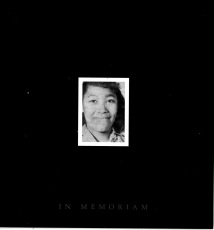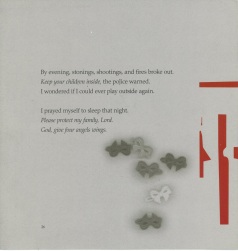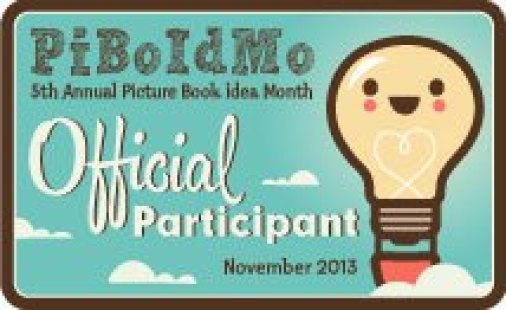 This week in September reminds us of sadness and tragedy. Earlier in the week, we recalled 9/11. Today marks the 50th anniversary of another bombing in our country – the Birmingham church bombing in 1963. Both incidents have taught us that, through this pain and devastation, we as a nation need to pull together because we are all one.
This week in September reminds us of sadness and tragedy. Earlier in the week, we recalled 9/11. Today marks the 50th anniversary of another bombing in our country – the Birmingham church bombing in 1963. Both incidents have taught us that, through this pain and devastation, we as a nation need to pull together because we are all one.
 So as we think back on September 15, 1963, I wanted to host Carole Boston Weatherford today. Carole has written many books that deal with civil rights, and her picture book Birmingham, 1963 is a must-read. Hauntingly and beautifully, she retells the story through the eyes of a ten-year-old child.
So as we think back on September 15, 1963, I wanted to host Carole Boston Weatherford today. Carole has written many books that deal with civil rights, and her picture book Birmingham, 1963 is a must-read. Hauntingly and beautifully, she retells the story through the eyes of a ten-year-old child.
Paired with Carole’s poignant free verse, the illustrations and photographs from that era tell the heartrending story of how hatred and cruelty destroys lives. Four young girls lost their lives that day. Their deaths shocked the world and shone a light on the injustices ripping society apart. The Birmingham explosion, which occurred less than a month after Martin Luther King, Jr. delivered his “I Have a Dream” speech, became a catalyst for change and turned the tide in the struggle for equality.
Although we still have many hurdles to overcome to make this a true land of equality for everyone, I have faith, as MLK did, that “unarmed truth and unconditional love will have the final word.”
So today, I’ve invited Carole Boston Weatherford to share her creative process with us. She has also generously provided many resources for teachers, and her publisher Boyd’s Mills Press has given us a copy of one of Carole’s books, Becoming Billie Holliday, as a giveaway. Anyone who comments on the blog or on Facebook, will have a chance to win this beautiful book. And this fall, Carole is also offering free Skype visits to any schools that read Birmingham, 1963.
 Because today is my birthday and this story is told from by a girl celebrating her 10th birthday, I chose this as my first question for Carole:
Because today is my birthday and this story is told from by a girl celebrating her 10th birthday, I chose this as my first question for Carole:
Why did you set the tragedy on the narrator’s birthday?
In the eyes of children, turning ten is a big deal, a childhood milestone bordering on a rite of passage. The bombing actually occurred on the church’s Youth Day. To compound the irony and up the emotional ante, I made the bombing coincide with the narrator’s tenth birthday. The main character is looking forward to singing a solo during worship service and to celebrating her birthday. Instead, she survives a church bombing and mourns four older girls. That setting dramatically juxtaposes birthday candles and the bundle of dynamite which sparked the explosion. The milestone resonates like a mantra, beginning as The year I turned ten and building to The day I turned ten.
Do you have a favorite passage from the poem?
The last stanza is my favorite.
Why did you choose historical fiction and create an anonymous narrator?
The historical events are true, but the first-person narrator is fictional. I use historical fiction to give young readers a character with whom to identify. In so doing, young readers grapple with social justice issues. I did not want names of fictional characters to stick in readers’ minds or to take the focus off the real victims. Also, the narrator’s anonymity draws readers even closer to the action. In this scene, she struggles to get out of the church after the blast.
Smoke clogged my throat, stung my eyes.
As I crawled past crumbled plaster, broken glass,
Shredded Bibles and wrecked chairs—
Yelling Mama! Daddy!—scared church folk
Ran every which way to get out.
The flow of your free verse is beautiful. Can you tell us why you chose it to tell this particular story?
From the start, I used poetry to tell the story. My early drafts in third person, however, lacked immediacy. So I decided on historical fiction and created a fictional first-person narrator. To layer the plot a bit, I set the action on the anonymous narrator’s tenth birthday. For rhythm and resonance, I employed repetition: “The year I turned ten…”; and “The day I turned ten….” What would have been a childhood milestone, she remembers instead for violence.
Birmingham, 1963 is an elegy. But it is also a narrative poem of historical fiction. Poetry allows me to conjure images and distill emotions that make the story powerful.
Did you see yourself in the four girls? How much of you is in the anonymous narrator?
In 1963 I was seven years old and had already written my first poem. I grew up in Baltimore and did not experience the degree of discrimination that they did in Birmingham. But In many ways, I was those girls.
Like Addie Mae Collins, I drew portraits, played hopscotch and wore my hair pressed and curled.
Like Cynthia Wesley, I was a mere wisp of a girl who sometimes wore dresses that my mother sewed. I sang soul music and sipped sodas with friends.
Like Denise McNair, I liked dolls, made mud pies, and had a childhood crush. I was a Brownie, had tea parties, and hosted a neighborhood carnival for muscular dystrophy. People probably thought I’d be a real go-getter.
Like Carole Robertson, I loved books, earned straight A’s and took music and dance lessons. I joined the Girl Scouts and was a member of Jack and Jill of America. I too hoped to make my mark. We are both Caroles with an “e.”
As an author/illustrator myself, I’m fascinated by the cover and page design, particularly the red marks on the page and the juxtaposition of photos and paintings. Can you tell us more about that?
So many children ask me whether racial injustices really happened. Children just can’t believe that grownups allowed such wrongs. Documentary photographs confirm for young readers that this history is indeed true. Just as childhood innocence confronted racial hatred that Birmingham Sunday, stark news photos contrast with snapshots of girly toys and trinkets in Birmingham, 1963. Powerful pictures speak to me. I hope that the images will affect young readers as well.
The designer, Helen Robinson, asked for a list of everyday items that the anonymous narrator might own. I thought back to my childhood in the Sixties. Armed by my list, Robinson had the text on verso pages overprint such props as barrettes, bracelets, Barbie doll clothes, birthday candles, 45 records, jacks, an eraser, embroidered white gloves, lace-trimmed socks, pencils, and a puffed heart locket. The commonplace items symbolize youthful innocence and serve as historical touchstones.
The red marks are also Helen’s conception. On their meaning, she is mum, but she allowed me this interpretation. The random red marks evoke broken glass, the shattering of innocence, and the shedding of blood.
It seems fitting that this anniversary falls on a Sunday because the bombings happened in a church so many years ago. Birmingham, 1963 is set in a church. Is it religious?
The tragedy occurred at a church, so prayer, psalms, and religious songs go with the territory. That said, the freedom struggle is a battle of good versus evil. My grandfather was an activist preacher, and I wonder if I’m channeling him when my writing wades into spiritual waters. Though not overtly religious, Birmingham, 1963 would nevertheless be at home in a Sunday School lesson.
I wanted to close with one final image that I thought was the most powerful. You said that the stained glass window of Jesus almost survived the blast intact.
10:22 a.m. The clock stopped, and Jesus’ face
Was blown out of the only stained glass window
Left standing—the one where He stands at the door.
It is ironic that Jesus was left faceless—as if He couldn’t bear to witness the violence. Here’s a photo.
Is the bombing still relevant more than 50 years later?
Nowadays, racism is usually more subtle and less definitive. Even hate crimes are more difficult to pinpoint and to prove….As long as racism persists and this nation exists, stories from the African-American freedom struggle will remain relevant.
So as we move beyond the tragedies of the past, what lessons can we learn and teach our children? In the words of MLK, “We must develop and maintain the capacity to forgive. He who is devoid of the power to forgive is devoid of the power to love.” So love is what we must pass on the the next generation, and that can only be taught through actions.
What lessons are you teaching through your life?
Here are some resources for anyone who wants to learn more about the church bombing:
Dr. King delivered the eulogy. He called the girls “martyred heroines of a holy crusade for freedom and human dignity.” Read the entire eulogy here.
Four days after the Birmingham church bombing, the president met with civil rights leaders at the White House. Among them was the Reverend Martin Luther King, Jr. who warned, “Birmingham has reached a state of total disorder.” Hear the White House tape.
Links to Classroom Resources
Free Film Kits (from Teaching Tolerance Magazine) – Mighty Times: The Children’s March and America’s Civil Rights Movement: A Time for Justice
Birmingham Public Library Digital Collections – Sixteenth Street Baptist Church Collection
Birmingham Civil Rights Institute
The King Center
The Rise and Fall of Jim Crow (PBS) – For Teachers
Eyes on the Prize (PBS) – For Teachers
Teachers Guide Primary Source Set – Jim Crow in America
Songs of the Civil Rights Movement (NPR)
Photographs of Signs Enforcing Discrimination (Library of Congress)
Win a FREE Book:
To win a free copy of Carole Boston Weatherford’s touching biography, Becoming Billie Holliday, leave a comment below or on Facebook to be entered in the drawing any time until September 30, 2013. A winner will be announced on October 1, 2013.

















